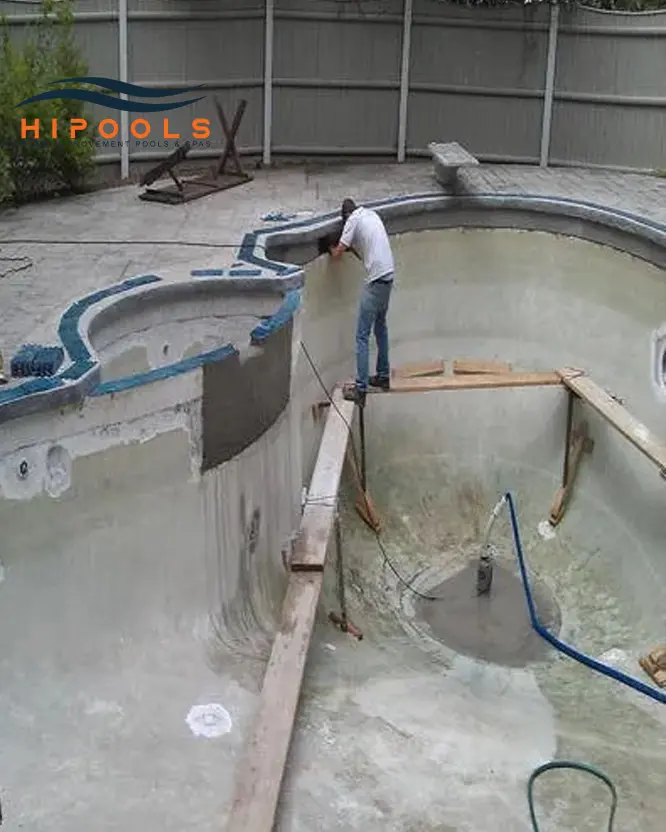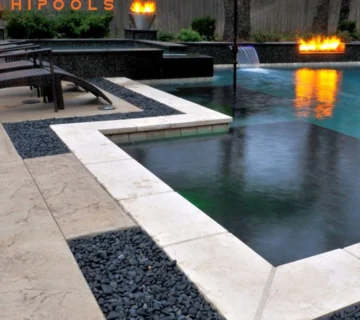Installing a pool for the first time is an exciting yet daunting task. Whether you’re dreaming of a luxurious backyard oasis or simply want a place to cool off during the summer, getting your pool installation right is key to ensuring it’s enjoyable for years to come. From choosing the right materials to understanding pool installation costs, there are many things to consider.
But don’t worry! We’ve compiled essential pool building tips to walk you through the journey. Let’s examine the most critical things you need to know as a first-time pool builder so that your pool project is successful.
Major Factors to Consider Before You Start Your First Pool Installation
Building a pool for the first time is not quite as easy as a hole in the ground and some water. There are several important things to consider that will impact the overall success of your pool project. From selecting the best pool materials to understanding the pool permits where you live, planning carefully is the key. The following are a few important considerations to keep in mind as you begin your pool installation process:
- Pool Design and Size: Decide on the shape, size, and depth of your pool so that it fits your area well and meets your requirement. Whether you are going for an inground pool or an above ground pool, a properly planned layout will save you from headache down the road.
- Selecting the Appropriate Materials: Your materials of choice will determine how long your pool lasts, whether you need to maintain it or not, and its appearance. You can choose either fiberglass, concrete, or vinyl depending on your budget and your personal preference. All three have advantages and disadvantages, so you need to select them accordingly.
- Installation Cost and Budget: The total installation cost is important to understand. Keep in mind not just the supplies but also labor to install a pool, permits, and other added features you may want, such as decking or landscaping. Expect some additional expenses along the way.
- Pool Permits and Regulations: Before starting, make sure you’re aware of the permits and local regulations that govern pool installations in your area. These rules often cover everything from pool fencing to water drainage, and failing to comply can lead to costly delays.
- Maintenance Needs of Pool: Think about the maintenance needs of your pool before you have it installed. Some pools and finishes require more upkeep than others. Understanding the needs of maintenance can help you choose the right materials for your pool and features that you can manage within the time you have available for maintenance.
- Choosing a Pool Contractor: If you’re hiring a contractor, do your research. Look for experienced professionals who have a good track record in pool building. Get multiple quotes and check reviews to ensure you’re working with someone reliable and trustworthy.
Pool Design and Size for First-Time Builders
When it comes to pool installation, the selection of the right design and size is one of the most important factors for a pleasurable and successful experience. The design you choose will directly impact the look, usability, and cost of your pool, while the size will determine how well it will integrate into the space you have available. Here’s the inside scoop:
1. Pool Shape and Style
Your pool shape should fit your backyard area and your personal needs. Most common pool shapes are rectangular, freeform, and kidney-shaped, but more customized shapes like L shaped or oval are also possible. For a classic look, a rectangular pool is a good bet, while a freeform pool is more of a natural, organic look. Consider the overall aesthetic of your home and garden so that the pool adds to your outdoor living space.
read for more information about Ultimate Guide to Rectangle Swimming Pools

2. Size and Proportions
Your pool size must be relative to your space and to the number of users. Although a large pool sounds attractive, factor the space remaining for other backyard amenities like a deck, patio, or garden. A small, tight pool might be the ideal option if you have little space, while a larger pool can offer extra room for swimming laps, sunbathing, or hosting pool parties. Provide enough room for pool equipment, walkways, and safe entry to the pool for maintenance.
3. Pool Depth
Your pool’s depth is also a determining factor. If you’re only going to use your pool for recreation and relaxation, you can manage with the standard 4-6 feet. If you swim laps or dive, however, you may want to go with a deeper pool with an area of 6 to 8 feet. More water translates to deeper pools, and deeper pools are more expensive to install and maintain.
Taking time to plan the size and design of your pool meticulously means that it is tailored to your space, lifestyle, and budget, which makes your initial pool installation an enjoyable experience.
Choosing the Right Pool Materials for Your First Installation
In pool installation, the proper material choice is a critical decision that impacts your pool’s longevity, aesthetics, and long-term upkeep needs. As a first-time pool installer, being aware of the different material choices and their respective benefits will help you make the correct decision. Below is an overview of the most common pool materials to consider:
1. Concrete Pools
Concrete pools are great for anyone wanting a highly custom pool. Concrete can be formed into any design, meaning your pool will have a distinctive one-of-a-kind appearance unique to your yard area. Unfortunately, concrete pools do cost more to install and have more to perform in upkeep, including the necessity of being resurfaced every 10 to 15 years. Concrete also happens to be more absorbent, and with this, it results in increased cleaning and the need for more chemicals. But if you’re looking for a durable pool material that offers flexibility in design, concrete is an excellent option.
2. Fiberglass Pools
Fiberglass pools are pre-molded and come in a range of shapes and sizes, which make them a popular choice for homeowners who require a quick and affordable installation. Fiberglass pools are extremely low maintenance due to their smooth surface, which makes them easier to clean and resistant to algae growth. Fiberglass pools are also extremely durable and resistant to cracking, which makes them a good long-term investment. They offer less shape customization than concrete pools, however.
3. Vinyl Pools
Vinyl-lined pools are generally the most economical. The surface is smooth, soft, and easy to clean and take care of. Even though installation is cheaper, the vinyl liner will have to be replaced 7 to 10 years later, which is added to the cost in total. Still, vinyl pools are a great choice for new builders who would like a low-cost pool with lower maintenance.

4. Local Considerations for Georgia Pool Builders
While constructing a pool in Georgia, consider your local weather and soil conditions while selecting materials. For instance, concrete pools will be most suitable for areas with fluctuating temperatures because they are capable of resisting harsh weather. On the other hand, fiberglass may be the most suitable for hot climates as it can withstand extreme weather.
Ultimately, the most suitable pool material for your installation will be determined by your budget, maintenance preferences, and preferred pool design. Considering these factors will guarantee a lasting and enjoyable pool experience.
Budgeting Your Pool Installation and Construction Costs
In new pool installation, it is vital to know how much the installation costs so that you can enjoy a stress free and hassle-free project. The installation cost of a pool might vary depending on several factors, including the material you will employ, the size of the pool, the level of complexity in the design, and the type of installation. This is how you can budget your pool construction budget wisely:
1. Material Costs
The material you choose will make a big difference in how much your pool overall will cost. Concrete pools typically are the most expensive since they are available in so many custom styles and need a high-intensive labor installation. Fiberglass pools will be the likely less expensive option, especially when you add in the reduced maintenance costs down the road. Vinyl pools cost the least upfront but will run you liner replacement every 7,10 years. Make sure to factor in the long term expenses as well while choosing your pool material.

2. Additional Features
Consider any additional features you may wish to include in your pool installation, such as water features, pool lighting, or heating systems. These are extras that can significantly contribute to your overall installation cost, so make sure to set priorities for what you actually need. Energy efficient features, such as solar heating systems or LED lighting, can cost themselves off in the long term and are a good option for long-term sustainability.
3. Labor and Contractor Costs
Hiring the right contractor is critical to keeping costs under control. When getting quotes from pool contractors, ensure they provide a detailed breakdown of labor, materials, and any other potential costs. Be sure to ask about hidden fees, such as permit costs and site preparation fees. If you’re in Georgia, factor in regional labor rates, which can vary by area.
4. Permits and Regulations
Prior to beginning your project, contact your local government to learn about the pool permits needed in your jurisdiction. The fees associated with acquiring these permits will differ based on your location, and not obtaining them may cause a delay in your project and additional expenses. In Georgia, certain counties have regulations for pool fencing and safety features that might increase your cost.

By carefully planning your pool installation costs and considering the materials, features, and contractor fees, you can make your initial pool project affordable while still meeting your design and functionality needs.
Last words
At HiPoolss, we understand that the installation of your very first pool may be both thrilling and overwhelming. By considering the most important factors like pool design, material selection, budget planning, and local regulations, you’ll be better equipped to make sound decisions throughout the process. Regardless of whether you choose fiberglass, concrete, or vinyl, we’re here to guide you with expert advice and quality products that fit your needs and budget. With proper planning and the right resources, your dream pool is within reach.
Let HiPoolss help you create the perfect pool for your backyard and enjoy years of fun and relaxation.




No comment